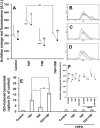Oxidant-induced autophagy and ferritin degradation contribute to epithelial-mesenchymal transition through lysosomal iron
- PMID: 28405169
- PMCID: PMC5378460
- DOI: 10.2147/JIR.S128292
Oxidant-induced autophagy and ferritin degradation contribute to epithelial-mesenchymal transition through lysosomal iron
Abstract
Purpose: Transforming growth factor (TGF)-β1 triggers epithelial-mesenchymal transition (EMT) through autophagy, which is partly driven by reactive oxygen species (ROS). The aim of this study was to determine whether leaking lysosomes and enhanced degradation of H-ferritin could be involved in EMT and whether it could be possible to prevent EMT by iron chelation targeting of the lysosome.
Materials and methods: EMT, H-ferritin, and autophagy were evaluated in TGF-β1-stimulated A549 human lung epithelial cells cultured in vitro using Western blotting, with the additional morphological assessment of EMT. By using immunofluorescence and flow cytometry, lysosomes and ROS were assessed by acridine orange and 6-carboxy-2',7'-dichlorodihydrofluorescein acetate assays, respectively.
Results: TGF-β1-stimulated cells demonstrated a loss of H-ferritin, which was prevented by the antioxidant N-acetyl-L-cysteine (NAC) and inhibitors of lysosomal degradation. TGF-β1 stimulation generated ROS and autophagosome formation and led to EMT, which was further promoted by the additional ROS-generating cytokine, tumor necrosis factor-α. Lysosomes of TGF-β1-stimulated cells were sensitized to oxidants but also completely protected by lysosomal loading with dextran-bound deferoxamine (DFO). Autophagy and EMT were prevented by NAC, DFO, and inhibitors of autophagy and lysosomal degradation.
Conclusion: The findings of this study support the role of enhanced autophagic degradation of H-ferritin as a mechanism for increasing the vulnerability of lysosomes to iron-driven oxidant injury that triggers further autophagy during EMT. This study proposes that lysosomal leakage is a novel pathway of TGF-β1-induced EMT that may be prevented by iron-chelating drugs that target the lysosome.
Keywords: A549 cells; COPD; pulmonary disease; pulmonary fibrosis; transforming growth factor; tumor necrosis factor.
Conflict of interest statement
Disclosure The authors report no conflicts of interest in this work.
Figures






Similar articles
-
TGF-beta1 induces human alveolar epithelial to mesenchymal cell transition (EMT).Respir Res. 2005 Jun 9;6(1):56. doi: 10.1186/1465-9921-6-56. Respir Res. 2005. PMID: 15946381 Free PMC article.
-
Ferritin heavy chain-mediated iron homeostasis and subsequent increased reactive oxygen species production are essential for epithelial-mesenchymal transition.Cancer Res. 2009 Jul 1;69(13):5340-8. doi: 10.1158/0008-5472.CAN-09-0112. Epub 2009 Jun 16. Cancer Res. 2009. PMID: 19531652
-
Autophagy links β-catenin and Smad signaling to promote epithelial-mesenchymal transition via upregulation of integrin linked kinase.Int J Biochem Cell Biol. 2016 Jul;76:123-34. doi: 10.1016/j.biocel.2016.05.010. Epub 2016 May 10. Int J Biochem Cell Biol. 2016. PMID: 27177845
-
Chinese medicine Bu-Fei decoction attenuates epithelial-mesenchymal transition of non-small cell lung cancer via inhibition of transforming growth factor β1 signaling pathway in vitro and in vivo.J Ethnopharmacol. 2017 May 23;204:45-57. doi: 10.1016/j.jep.2017.04.008. Epub 2017 Apr 12. J Ethnopharmacol. 2017. PMID: 28412214
-
Tumor necrosis factor-alpha enhances both epithelial-mesenchymal transition and cell contraction induced in A549 human alveolar epithelial cells by transforming growth factor-beta1.Exp Lung Res. 2010 Feb;36(1):12-24. doi: 10.3109/01902140903042589. Exp Lung Res. 2010. PMID: 20128678
Cited by
-
A novel view of ferritin in cancer.Biochim Biophys Acta Rev Cancer. 2023 Jul;1878(4):188917. doi: 10.1016/j.bbcan.2023.188917. Epub 2023 May 18. Biochim Biophys Acta Rev Cancer. 2023. PMID: 37209958 Free PMC article. Review.
-
Ferritinophagy-Mediated Ferroptosis and Activation of Keap1/Nrf2/HO-1 Pathway Were Conducive to EMT Inhibition of Gastric Cancer Cells in Action of 2,2'-Di-pyridineketone Hydrazone Dithiocarbamate Butyric Acid Ester.Oxid Med Cell Longev. 2022 Feb 21;2022:3920664. doi: 10.1155/2022/3920664. eCollection 2022. Oxid Med Cell Longev. 2022. PMID: 35237380 Free PMC article.
-
New Iron Metabolic Pathways and Chelation Targeting Strategies Affecting the Treatment of All Types and Stages of Cancer.Int J Mol Sci. 2022 Nov 13;23(22):13990. doi: 10.3390/ijms232213990. Int J Mol Sci. 2022. PMID: 36430469 Free PMC article. Review.
-
DpdtC-Induced EMT Inhibition in MGC-803 Cells Was Partly through Ferritinophagy-Mediated ROS/p53 Pathway.Oxid Med Cell Longev. 2020 Mar 12;2020:9762390. doi: 10.1155/2020/9762390. eCollection 2020. Oxid Med Cell Longev. 2020. PMID: 32256964 Free PMC article.
-
FtH-Mediated ROS Dysregulation Promotes CXCL12/CXCR4 Axis Activation and EMT-Like Trans-Differentiation in Erythroleukemia K562 Cells.Front Oncol. 2020 May 5;10:698. doi: 10.3389/fonc.2020.00698. eCollection 2020. Front Oncol. 2020. PMID: 32432042 Free PMC article.
References
-
- Willis BC, Borok Z. TGF-beta-induced EMT: mechanisms and implications for fibrotic lung disease. Am J Physiol Lung Cell Mol Physiol. 2007;293(3):L525–L534. - PubMed
-
- Nowrin K, Sohal SS, Peterson G, Patel R, Walters EH. Epithelial-mesenchymal transition as a fundamental underlying pathogenic process in COPD airways: fibrosis, remodeling and cancer. Expert Rev Respir Med. 2014;8(5):547–559. - PubMed
-
- Cannito S, Novo E, di Bonzo LV, Busletta C, Colombatto S, Parola M. Epithelial-mesenchymal transition: from molecular mechanisms, redox regulation to implications in human health and disease. Antioxid Redox Signal. 2010;12(12):1383–1430. - PubMed
-
- Arsalane K, Dubois CM, Muanza T, et al. Transforming growth factor-beta1 is a potent inhibitor of glutathione synthesis in the lung epithelial cell line A549: transcriptional effect on the GSH rate-limiting enzyme gamma-glutamylcysteine synthetase. Am J Respir Cell Mol Biol. 1997;17(5):599–607. - PubMed
LinkOut - more resources
Full Text Sources
Other Literature Sources

